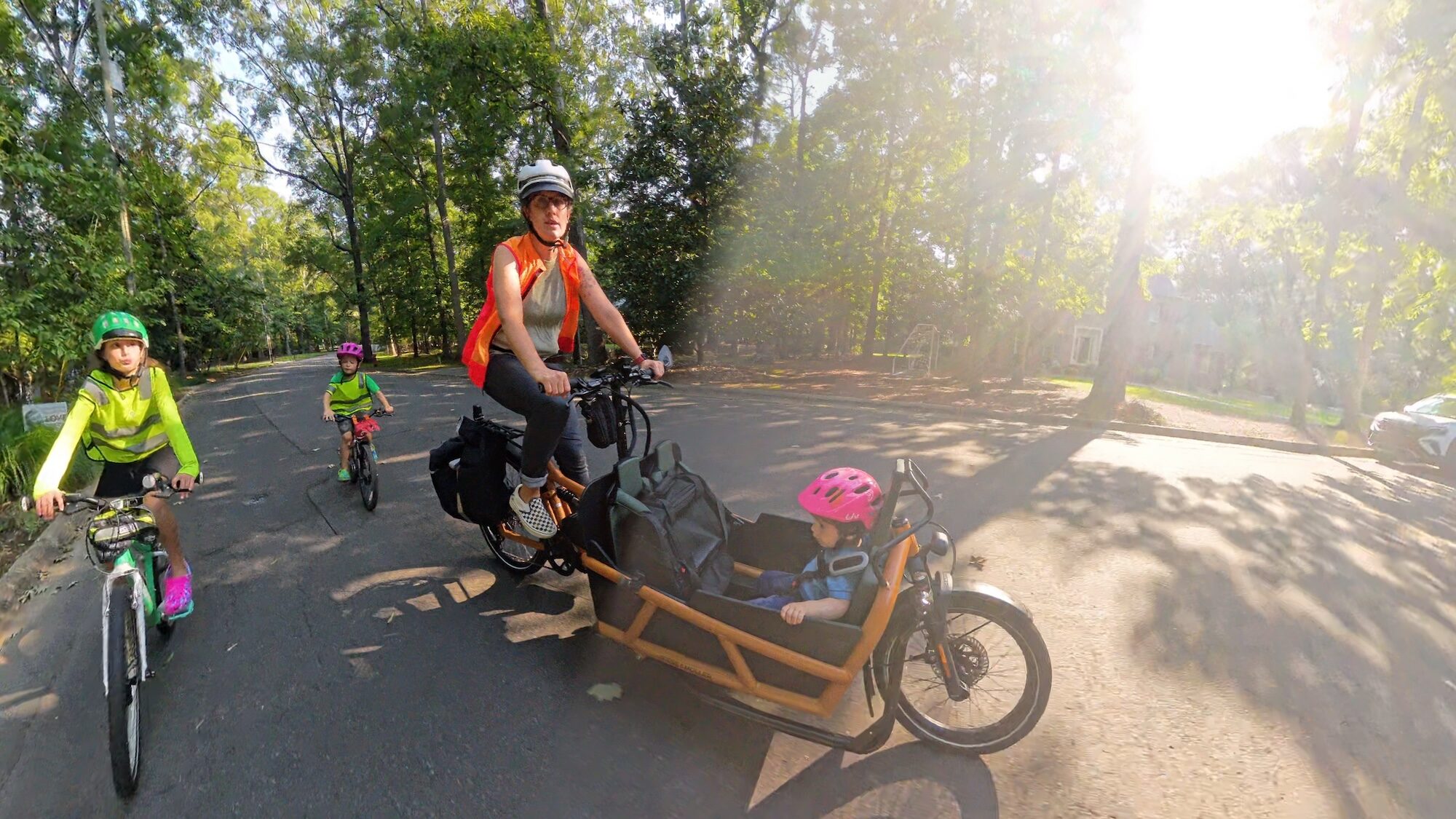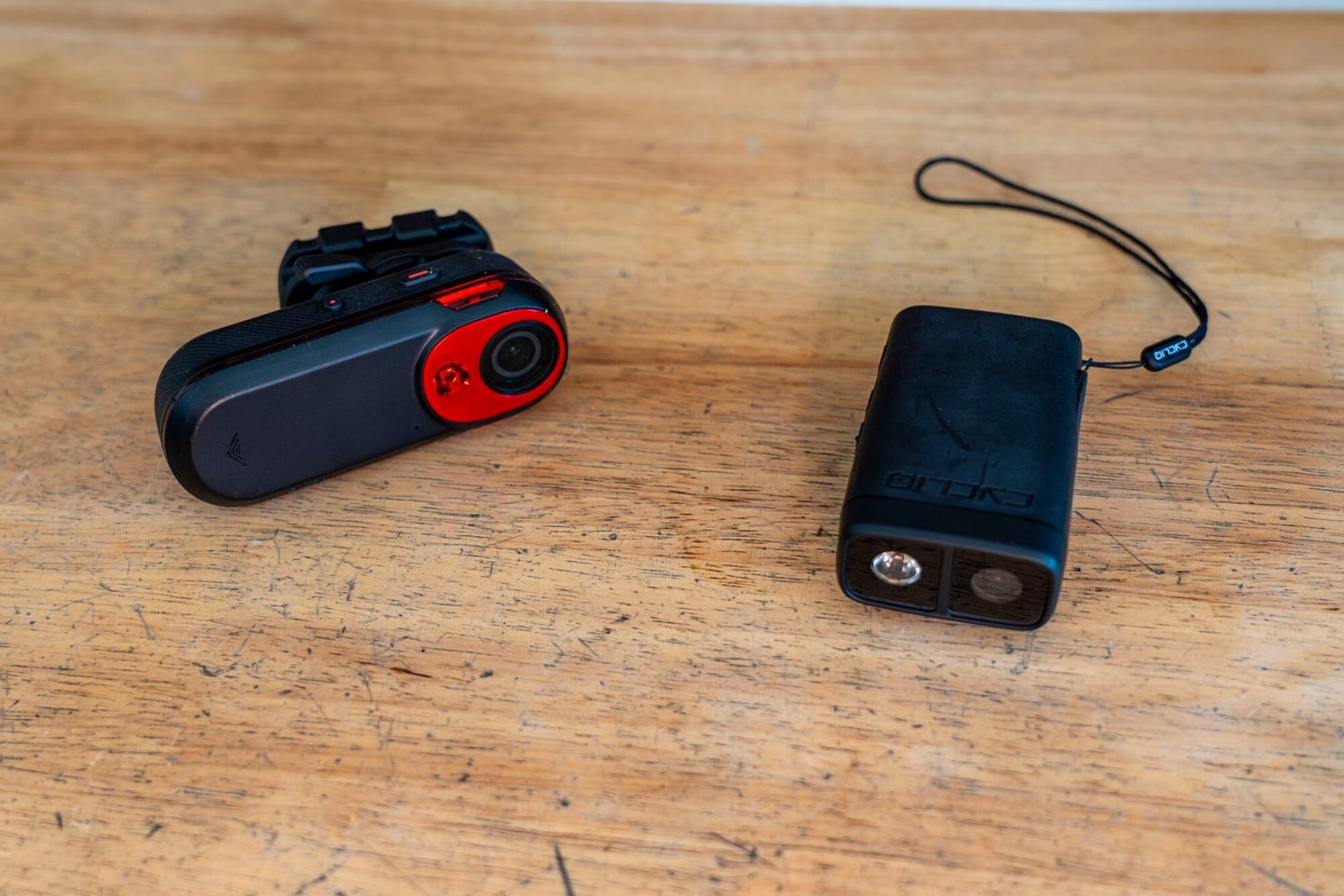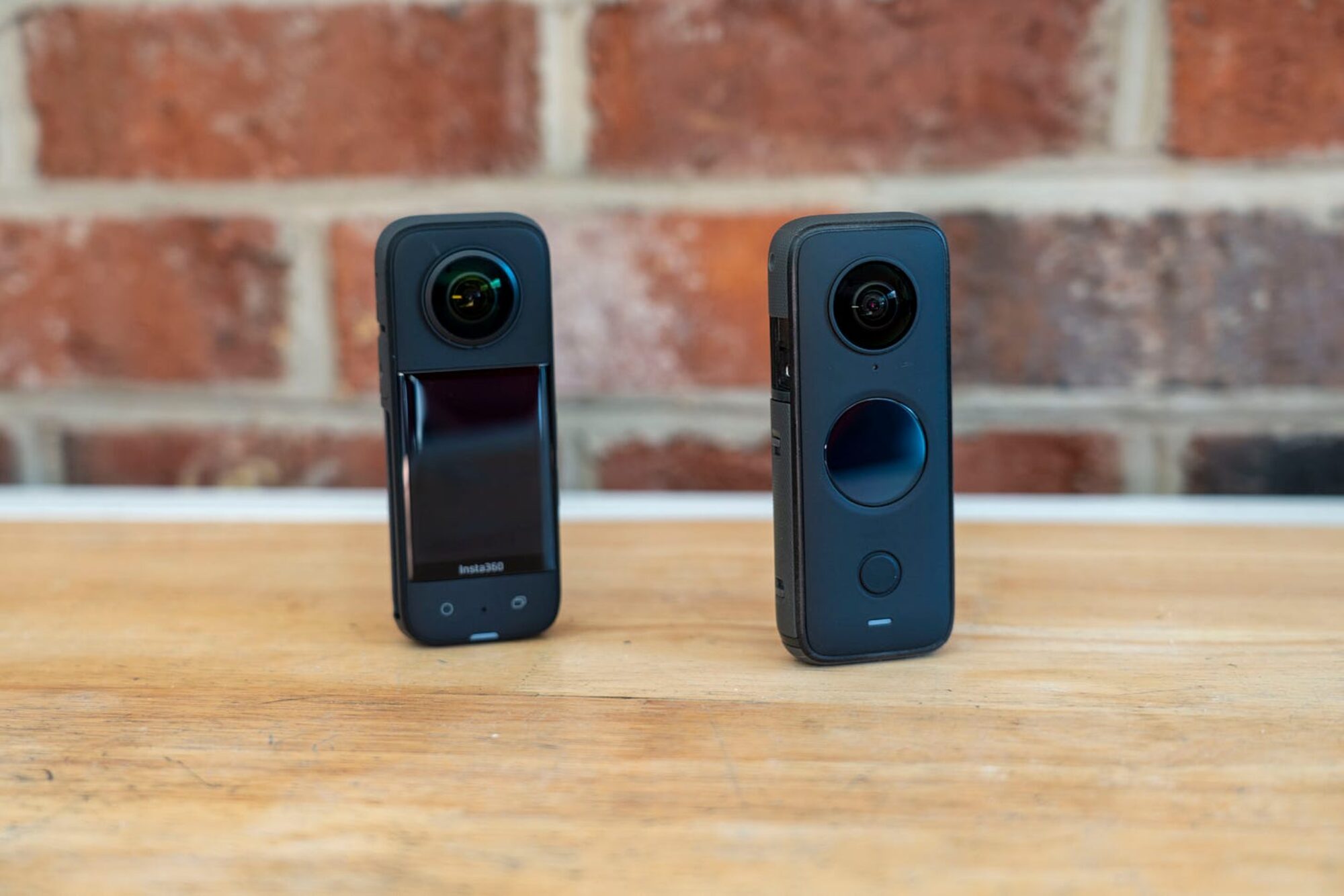Whether you are here to learn about the best action cameras, capturing footage in case of a bike crash, or my favorite small cameras for carrying on the bike, I hope this bike camera guide helps you capture your cycling adventures and share the love of biking.
Importance of Bicycle Cameras
There are many reasons you may have landed on this bike camera guide so make sure to check out that index above! Whatever the reason you are looking into bicycle cameras, I guess that it fits into one of these 3 distinct use cases or categories:

Capturing cycling experiences like specific bike trails, cycling routes, or group rides. You want to show off that epic ride, or in my case, I often show how to get around my town safely so I’m looking for a stable point of view like you were riding with me.

Enhanced cycling safety and using it as a biking dash cam in the case of a crash, accident, or hit-and-run. These cameras need to have great battery life and really good camera resolution to make sure you are getting that license plate if you need it.

Documenting a story from the bike but not necessarily the actual route. This could include biking to a destination and photographing the landscape around you, capturing your friend’s latest sweet gravel bike, and capturing the feeling of the adventure and less of the tactical “this is where I rode today”. For me, this could be talking to the camera as I ride somewhere to “set the stage” and share what is happening or it could be trying to get unique views of my bike that I’m reviewing.
Each of these unique categories has different needs for the camera, mounting system, and user interface. I hope this bike camera guide helps you find the right camera for you. Post a comment to let me know what type of biking you are documenting and how!

What is a Bike Action Camera?
Before we dig in too far, I wanted to set the table a bit on what a bike action camera is and some basics of what you should expect out of it.
Action cameras are typically pictured as a GoPro style. A form factor that is small, rugged, and designed to be beat up. They are often drop-proof from a bike height, have some type of water protection, and are designed to take more of a beating than your standard camera or phone. You can take photos or videos with bike action cameras but you typically see video being recorded the most. Most have multiple shooting modes from photo, video, time-lapse, hyper-lapse, and more. You’ll see there are a few outliers mentioned below including 360º cameras, and some with built-in gimbals for really stable high-end footage.
In 2024, you’ll see all the main competitors offering 4-5.3k recording at 30-60fps, with around an hour of record time with a fresh battery and some type of internal stabilization.
Best Bike Cameras in 2024
If I were buying a new bike camera, it would be one of these 4
| Product Image | Product Name / Description | Price / Primary Button / Secondary Button |
|---|---|---|
|
|
|
|
|
|
|
|
|
|
|
|
|
|
Get the most unique angles and also be able to reframe to tell a better story after.
The Action 5 has better colors and stabilization, but the price on the Action 4 is hard to beat!
It is the only dedicated cycling camera and light I recommend.
The best camera to quickly show an overlay of your speed with built-in app integration with Garmin and Apple Fitness
Types of Bicycling Cameras
“GoPro” Style
This form factor was created by GoPro, it has a nice little solid feel with a mount on the bottom either with the GoPro prong style or with snap-in magnet mounts. It typically has basic buttons on one or two sides to make it easy to use on the go, with gloves, or in the water.
Pros: Most common setups, easy to get started, and can make great content
Cons: Shorter run time than a dedicated dash cam, I wouldn’t leave it on the bike
The most popular cycling cameras in late 2024 are the DJI Action 4, the newer DJI Action 5 Pro because it has better colors and handles shadows well, the Insta360 X4 or X3 360 cameras, and the GoPro Hero 12.

Dedicated Cycling Dash Cam Style
These cameras are specifically designed to be mounted to the front or rear of a bike. They normally have a built in light, great run time, and the user app is specifically designed to pull footage incase of a crash or incident.
These cameras are great for those that just want to have something running at all time, and not think about it other than to charge.
My favorite right now is either the Garmin Varia RCT715 or the Cycliq Fly6 Pro is what I run personally on my bike.

360 Cycling Cameras
360º cameras are very cool tech that captures footage from all around the camera with the two huge lenses, and then software “stitches” it all together to make a seamless orb video or photo around you. You can then flatten the image into a typical horizontal or vertical view and reframe it in whichever direction you want. If you want to understand this more, check out this video.
Insta360 with the X4 and X3 are dominating this space but GoPro has the Max 360 which has been out for a while. The footage is good from the GoPro Max but GoPro seems to have forgotten about the app and keeping things moving forward. Maybe they are developing something new. Gosh, I sure hope so!
Pros: Great stabilization, no need to worry about where your camera is pointed, get unique points of view angles
Cons: Not good in low light conditions, not durable due to the lens cover bulging out
This is my reminder to cover 360 action cameras more in-depth in another article!
Unique Cycling Cameras
There are a handful of unique cycling cameras I’m testing right now that are very one-off use cases or more focused on grabbing out of a pocket and bag with one hand and documenting a story around you. The Insta360 Go 3, DJI Pocket 3, and HoverAir drone are great examples of this.
Common Bike Camera Mounting
I have my camera in 4 typical setups on my bike:
Handlebar-mounted
9 times out of 10 I have at least one camera on and it is on my handlebar. For documenting bike rides for viewing pleasure vs coverage if I’m to be hit, I normally have the GoPro Hero11 or Insta360 X3 but I may switch to the Insta360 Ace Pro if it doesn’t have any overheating concerns.
Handheld
This is my 2nd most common setup after mounting to my handlebar. I typically have a camera of some style quickly available in a bag on my stem or backpack shoulder strap. This allows me to capture footage not directly in front of my bike, and it also allows me to hold the camera closer to my face for better audio.
Chest mounted
This is a common point of view for mountain bike footage. The camera is much more stable this way but you have to be okay with your arms and handlebar in all video or photo footage.
Mounted to my helmet
This is a really fun position to put a 360º camera to capture all around you, or to put on a mountain biking helmet to get a clearer view. It does add some weight to your helmet which could be a nuisance for longer rides.
Dashcam mounting
I have found the Dashcam mounting options to be a bit limited to use on non-traditional road-style bikes. All my cargo bikes require some type of hacking to get them to mount well and cameras like Cycliq or Garmin Varia all use unique mounting which then requires additional custom brackets.
If you want to see all the top bike camera accessories I use, check out my top bike camera accessories from 2023.
Key Features to Consider
There are so many cool things that cycling cameras can do these days, and it comes down to what you are trying to capture. Here are some of the key things I look at when reviewing new bike camera tech.
Video Quality, Resolution, and Low-Light Performance
The higher the resolution and bit rate, the more you can crop in and edit after. Some cameras also do better in low-light performance. You may read that and think “I don’t want to take videos at night” but it may simply be a cloudy day and you are biking in the shadows. Without good low-light performance that video may turn out very grainy or worthless.
The higher the resolution and bit rate, the more memory you need. Some cameras have built-in memory (not ideal) which limits how much you can record. Many cameras also come with cheaper.
Image Stabilization Technology
All of these action cameras have different types of image stabilization built-in using the software to stabilize the footage. This creates a balancing act for the quality of your footage because it normally requires cropping in of an image to stabilize the footage, and the stabilization requires decent lighting to make the brains of the software all work right.
With that in mind, I am typically using 30fps to let the most light into my sensor, shooting the highest resolution, and a wider setting than I ultimately want so that the software can have room to crop when it is stabilizing.
Loop Recording
If you are trying to record for safety then Loop Recording could be crucial for you. This tells the camera to record for x amount of time and then writes over that footage.
Mounting Options and Point of View Angles
We discussed my most popular mounting options and they all change which camera I’m going to use. Do you have a preferred angle you are trying to capture? Do you want a quick on-and-off setup? If you like 360 and want to be able to capture all around you then you are going to need a specific mounting setup. If you want unique shots, then a camera like the Insta360 Go3 or an Insta360 X2 and X3 camera would be cool to have.
Battery Life
There are a few key things I think about when talking about battery life.
- Is the battery removable? Some of my favorite cameras have become paperweights (or YouTube backgrounds) because the battery is dead and I can’t easily replace it.
- Can I charge it while recording? This is a must-have for me.
- Are the batteries easily purchased? One of the main reasons I always have a GoPro with me is that every major store in America carries batteries for it. I can’t say that for many of the smaller brands.
- USB-C charging – why is anyone making anything else these days?
Many cameras can now charge while recording, but this reduces their weatherproofness. With that in mind, think about how long you need the camera to run, and do you want to bring spare batteries with you?
One of my major to-do items for 2024 is to run power from my e-bike and dynamo hubs to a camera for unlimited recording time beyond what my memory card limits me to.
Weather Resistance
Unless you are a 100% fair-weather rider, you want some sort of weather protection for your camera. This removes some cameras from the equation for me to use daily (looking at you, Insta360 Go3).
User Interface
The user interface of the physical camera, as well as the phone app and computer software, is very important.
For me, they all need a quick start button that can be programmed for a quick push of a button to start recording in whatever option I have that button programmed. I also want some type of physical feedback that isn’t only a noise that I did it right, ideally, the button clicks a bit. GoPro has this nailed, some of the Insta360s work well (X3 doesn’t always work), and some of the DJIs work.
Next up is the camera user interface. How easy it is to get around to switching modes and settings? Can I quickly preview what I documented or is it multiple swipes and taps, or even worse – do I need to get out my phone?
For phone and computer software, I would say that Insta360, DJI, and GoPro all are doing great work here with some advantages of one over the other. Cycliq does the job sometimes, but I pull the microSD card and plug it into my computer without using any of their software, though I wish I could!
Connectivity Options
Bike cameras have all types of connectivity from WiFi to Bluetooth to connect to your phone or other setups like remotes or GPS trackers. I’ve tried a handful and haven’t found a ton of them useful, but hope to be surprised in 2024 with GoPro and Insta360!
Choosing the Right Bicycling Camera
The main things I ask when someone is looking for a camera recommendation:
- What are you using it for, and how will you edit the footage?
- What type of angles do you want to record?
- How long do you need it to run?
If your main goal is to have footage if something is happening simply, make sure it has a loop record option or a really big microSD card. If you will only be using your phone to pull and edit the footage, I would recommend GoPro, Insta360, or DJI, for their great phone interfaces. I highly recommend one with a removable battery and memory card to anyone reading this. If you need unique angles or want to get creative, then look at the 360 camera lineup.
Here’s an article all about my favorite bike camera setups right now.
What about Using Your Phone or a More Standard Camera?
You can absolutely use your phone for some of the use cases! I almost always have my iPhone 13 Pro within reach to quickly document or share a photo. When paired with my favorite bike phone mount I can even strap my phone to my handlebar and get pretty decent video footage!
Some folks who ride with a higher-end camera strapped to their shoulder or back. It really depends on your purpose. Are you out with the goal of capturing beautiful imagery and there is no way of you crashing? Let’s do it! I hope to do more of this in 2024 on group rides but have found my phone does a pretty great job and I prefer my camera tucked away in a bag on my back.
Tips for Using Bicycling Cameras Effectively
The first thing I recommend to folks is to test their camera angle to ensure they get the view they want. Most of these cameras connect to your phone for a live preview. Use that the first couple of times you use your camera to ensure you get the footage you want. I ride around for 2-3 minutes with it recording, don’t move the camera, and preview the footage on my phone with the Bluetooth or wifi connection.
The next thing I watch is my run time, battery life, and memory. Do I need an external battery for my rides? How much footage am I capturing? How is the cold impacting my battery life? Do I need to set up the loop recording?
The last thing is to engrain yourself with proper maintenance and care for these cameras. Try not to let the battery die, remember to clear off your footage often, and make a habit out of wiping off your lens before riding.
FAQs About Bicycling Cameras
4k Recording, good image stabilization, over an hour of battery life, and the ability to charge while using.
Yes, depending on how you mount it and what you are recording. If I haven’t brought a GoPro with me, I often record with my phone in my hand or strapped to my handlebar.
Yes! These are some of my favorite cameras for biking if you aren’t riding in low light that often
There are special sticky mounts with a slight curve for helmets. Make sure to clean off your helmet with rubbing alcohol first, and then apply letting it stick for a while before adding your camera. I try to balance putting the camera in a good location, but not making my helmet lopsided. A good-fitted helmet is also critical for this to be comfortable.
Most people use the software provided by their camera company. I use this when on the go and then pull footage into Final Cut Pro X for longer edits.
The most affordable cycling camera option I have found that I would use is a GoPro Hero8 or 9 starting around $200 .
Final Thoughts
Documenting your bike adventures can be a fantastic way to remember the moments, share your experiences, and a built-in safety if something goes wrong. I would love to hear from you about what you want to document, your camera setup, and any other great stories about cycling cameras!








